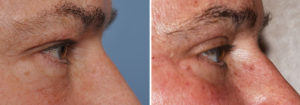Background: The eyes are the first area of the face to develop aging and are also often the first for patients to consider anti-aging surgery. Regardless of gender, the development of extra eyelid skin, wrinkling and a tired and older appearance are the hallmarks of the aging eyelid. When patients seek eyelid rejuvenation it can be for upper, lower or both eyelids depending upon the scope of their concerns.
The male blepharoplasty is a bit different than that of the female one. Historically, like many other facial aging concerns, they often present later in life with more advancing amounts of skin redundancies and laxity. (this is changing with today’s younger patients) Secondly they are more concerned about looking overdone and unnatural. (the so called Kenny Rogers effect) While they want good improvement they fear looking like they have had surgery more than having under done results. Men also have less tolerance for a prolonged recovery and any complication involved thereof.
In the male upper eyelid skin over resection must be avoided. Men do not look natural with a widely open supratarsal hollow or a lot of spacing/distance between their eyebrows and their lash lines. It is perfectly acceptable to have a small amount of residual hooding. In the lower eyelid an emphasis is always on limited skin removal and fat preservation/transposition if possible. Sagging of the lower eyelid with increased scleral show and lower eyelid hollowing are changes not viewed as a positive anti-aging effect.
Case Study: This older male as interested in improving the appearance of his eyes which gave him a tired appearance. His upper eyelids were heavy and had excess skin that hung down onto his lashes. His lower eyelids showed minimal excess skin and a small amount of fat herniation.
Under general anesthesia an upper blepharoplasty was performed with conservative skin removal (7mms at the central pupillary level) and a small strip of orbicularis muscle to help make the crease deeper. On the lower eyelids two millimeters of skin and fat was removed, cautery to the central and lateral fat pads was done and a lateral canthopexy with orbiculares muscle suspension performed.

Blepharoplasty remains the cornerstone of surgical facial rejuvenation. Far more complications and revisional procedures occur from trying to accomplish too much and sacrificing tissues needed to maintain good lid levels and positioning against the globe. Good functional blepharoplasties are also those that look the most natural and this is particularly appealing to the older male patient.
Highlights:
1) Blepharoplasty is an effective procedure for both the upper and lower eyelids with different risk factors for each type of eyelid.
2) Male blepharoplasty is as much about avoiding an over resected look as it is about improving the eyelid shape. There can be a fine line between these two outcomes.
3) A natural look in an older male upper blepharoplasty can still leave some minor amount of hooding.
Dr. Barry Eppley
Indianapolis, Indiana



